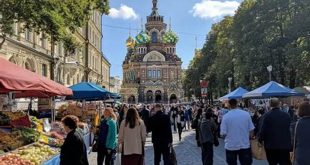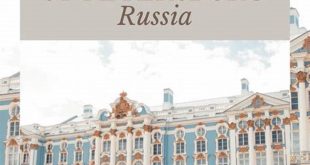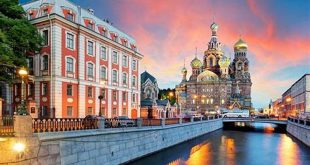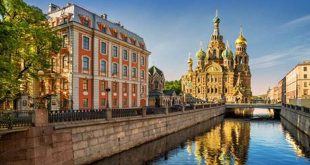How did St. Petersburg change Russian society? St. Petersburg, founded by Peter the Great in 1703, played a pivotal role in transforming Russia’s political, economic, and cultural landscape.
Editor’s Note: “How did St. Petersburg change Russia’s society?”. This topic published today to emphasis how the establishment of St. Petersburg as the new capital of Russia had a profound impact on the country’s development.
Our team has analyzed various historical accounts, research papers, and expert opinions, put together this guide to help you understand how St. Petersburg changed Russian society.
Key Differences:
| Before St. Petersburg | After St. Petersburg |
|---|---|
| Moscow was the capital | St. Petersburg became the capital |
| Russia was primarily an agricultural society | St. Petersburg fostered trade, industry, and the arts |
| Russian culture was heavily influenced by Byzantine traditions | St. Petersburg introduced Western European influences into Russian society |
Main Article Topics:
How St. Petersburg Changed Russian Society
The establishment of St. Petersburg as the new capital of Russia in 1703 marked a turning point in the country’s history. The city, built on the shores of the Baltic Sea, became a window to Western Europe and a catalyst for profound changes in Russian society.
- Political Center: St. Petersburg became the political center of Russia, replacing Moscow.
- Economic Hub: The city fostered trade, industry, and the arts, becoming an economic powerhouse.
- Cultural Gateway: St. Petersburg introduced Western European influences into Russian society, from architecture to literature.
- Intellectual Hub: The city became a center of learning, with the establishment of the Russian Academy of Sciences and other institutions.
- Military Stronghold: St. Petersburg’s strategic location made it a key military stronghold, protecting Russia from potential invasions.
- Imperial Capital: The city became the symbol of the Russian Empire, showcasing its power and grandeur.
- Melting Pot: St. Petersburg attracted people from all over Russia and beyond, creating a diverse and cosmopolitan society.
- Artistic Center: The city became a hub for artists, writers, and musicians, fostering a vibrant cultural scene.
- Social Change: St. Petersburg’s Western influences led to changes in social norms and customs, including the adoption of European fashion and manners.
In conclusion, St. Petersburg played a multifaceted role in transforming Russian society. It became the political, economic, cultural, and military center of the country, introducing Western European influences, fostering intellectual and artistic development, and shaping social norms. The city’s legacy continues to this day, as it remains a vibrant and influential metropolis at the heart of Russian society.
Political Center
The relocation of the political center from Moscow to St. Petersburg in 1703 had a profound impact on Russian society. Here are key facets of this change and their implications:
- Centralized Power: St. Petersburg’s establishment as the new capital centralized political power in the hands of the tsar. The tsar’s presence in the city allowed for more direct control over the government and administration, reducing the influence of regional elites.
- Modernization: St. Petersburg was built according to Western European models, reflecting Peter the Great’s desire to modernize Russia. The city’s architecture, infrastructure, and institutions were designed to be modern and efficient, signaling a shift away from traditional Russian practices.
- Bureaucratic Expansion: The transfer of the capital to St. Petersburg necessitated the creation of a new bureaucratic apparatus to support the government’s operations. This led to an expansion of the civil service and the development of a more complex administrative system.
- Cultural Transformation: St. Petersburg’s status as the political center attracted a diverse population from across Russia and Europe, creating a cosmopolitan and cultured society. The city became a hub for art, literature, and music, fostering a vibrant intellectual and cultural scene.
In conclusion, the relocation of the political center to St. Petersburg was a pivotal moment in Russian history. It centralized power, modernized the country, expanded the bureaucracy, and transformed the cultural landscape, contributing significantly to the overall changes in Russian society.
Economic Hub
St. Petersburg’s emergence as an economic hub played a crucial role in transforming Russian society. Here are key facets of this change and their implications:
- Trade and Commerce: St. Petersburg’s location on the Baltic Sea made it a major center for trade with Western Europe. The city’s port facilities and customs regulations encouraged the flow of goods, leading to economic growth and increased prosperity.
- Industrialization: Peter the Great’s policies promoted the development of industry in St. Petersburg. Ironworks, textile mills, and other factories were established, creating new job opportunities and contributing to the city’s economic output.
- Artistic Patronage: St. Petersburg became a center for the arts, with the patronage of the tsars and wealthy merchants. The city’s theaters, museums, and art academies attracted talented artists and musicians, contributing to the cultural enrichment of Russian society.
- Economic Inequality: The economic growth and industrialization associated with St. Petersburg’s economic hub status also led to increased economic inequality. The gap between the wealthy elite and the working class widened, creating social tensions.
In conclusion, St. Petersburg’s role as an economic powerhouse had a multifaceted impact on Russian society. It fostered trade, industry, and the arts, contributing to economic growth and cultural enrichment. However, it also exacerbated economic inequality, shaping the social dynamics of the city and the country at large.
Cultural Gateway
St. Petersburg’s role as a cultural gateway played a pivotal role in transforming Russian society by introducing Western European influences across various aspects of life. Here are key facets of this change and their implications:
- Architectural Transformation: St. Petersburg’s architecture reflected the influence of Western European styles, from Baroque to Neoclassical. Buildings designed by renowned architects like Bartolomeo Rastrelli and Giacomo Quarenghi showcased the latest trends in European architecture, transforming the city’s skyline and introducing new aesthetic sensibilities.
- Literary Renaissance: St. Petersburg became a hub for literary activity, attracting writers and poets from across Russia. The city’s literary salons and publishing houses fostered the development of new literary styles and genres, influenced by Western European literature. Alexander Pushkin, considered Russia’s greatest poet, spent formative years in St. Petersburg, contributing to its literary legacy.
- Artistic Exchange: St. Petersburg’s art scene was influenced by Western European trends, with artists studying and incorporating techniques and styles from abroad. The city’s art academies trained generations of artists, who played a crucial role in shaping the development of Russian art.
- Cultural Exchange: St. Petersburg became a meeting point for Russian and Western European intellectuals, artists, and scholars. This exchange of ideas and perspectives contributed to the development of a more cosmopolitan and open-minded Russian society.
In conclusion, St. Petersburg’s role as a cultural gateway had a profound impact on Russian society. It introduced Western European influences into architecture, literature, art, and intellectual life, contributing to the modernization and transformation of Russian culture and society.
Intellectual Hub
The establishment of St. Petersburg as an intellectual hub played a significant role in transforming Russian society. The city’s commitment to education and research fostered a new generation of thinkers and scholars, contributing to the advancement of science, culture, and society.
- Scientific Progress: The Russian Academy of Sciences, founded in 1724, became a leading center for scientific research. Scholars from across Russia and Europe flocked to St. Petersburg to collaborate and exchange ideas, contributing to groundbreaking discoveries in mathematics, physics, astronomy, and other fields.
- Educational Expansion: St. Petersburg became a center for higher education, with the establishment of universities and specialized institutes. These institutions trained professionals in various fields, including law, medicine, engineering, and the arts, contributing to the development of a more educated and skilled workforce.
- Cultural Enrichment: The intellectual hub status of St. Petersburg attracted writers, artists, and musicians from across the country. The city’s theaters, museums, and libraries became centers for cultural exchange and the development of new ideas and artistic expressions.
- Societal Transformation: The spread of knowledge and ideas through education and research had a transformative effect on Russian society. It fostered a more enlightened and critical citizenry, contributing to the development of a more open and progressive society.
In conclusion, the establishment of St. Petersburg as an intellectual hub was a major catalyst for change in Russian society. It promoted scientific progress, educational expansion, cultural enrichment, and societal transformation, contributing to the advancement and modernization of the country.
Military Stronghold
The establishment of St. Petersburg as a military stronghold had a significant impact on Russian society, shaping its development and security:
1. Strategic Defense:St. Petersburg’s location on the Baltic Sea provided a strategic advantage for defending against potential naval invasions from the west. The city’s fortifications and naval base played a crucial role in protecting Russia’s northwestern borders.
2. Military Buildup:The designation of St. Petersburg as a military stronghold led to a substantial increase in military presence in the region. Shipyards, arsenals, and training facilities were established, contributing to the growth of the Russian navy and army.
3. Economic Impact:The military buildup associated with St. Petersburg’s stronghold status stimulated economic activity in the city and surrounding areas. Industries related to shipbuilding, armament production, and logistics flourished, creating employment opportunities and boosting the regional economy.
4. Social Transformation:The influx of military personnel and their families into St. Petersburg led to a more diverse and cosmopolitan society. The city became a melting pot of different cultures and backgrounds, shaping its social fabric and cultural landscape.
5. Civic Pride and Patriotism:St. Petersburg’s role as a military stronghold fostered a sense of civic pride and patriotism among its residents. The city’s defense capabilities instilled a sense of security and national identity, contributing to the development of a stronger Russian national consciousness.
Imperial Capital
St. Petersburg’s designation as the imperial capital of Russia had a profound impact on the country’s society. Here are key facets of this change and their implications:
- Political and Administrative Center: St. Petersburg became the political and administrative center of the Russian Empire, housing the imperial court, government ministries, and foreign embassies. This concentration of power and authority transformed the city into the heart of the empire’s decision-making and governance.
- Economic Hub: As the imperial capital, St. Petersburg attracted merchants, entrepreneurs, and skilled workers from across the empire and beyond. The city’s economy flourished, becoming a major center for trade, industry, and finance.
- Cultural Showcase: St. Petersburg became a showcase for the empire’s cultural achievements. The city’s theaters, museums, and art galleries exhibited the finest works of Russian and European artists, writers, and musicians.
- Social Transformation: The influx of people from diverse backgrounds to St. Petersburg fostered a cosmopolitan and cultured society. New social norms and customs emerged, influenced by both Russian traditions and Western European ideas.
In conclusion, St. Petersburg’s role as the imperial capital transformed Russian society by concentrating political power, driving economic growth, showcasing cultural achievements, and fostering social change. The city became a symbol of the empire’s might, grandeur, and cultural aspirations.
Melting Pot
St. Petersburg’s status as a melting pot significantly contributed to the transformation of Russian society. The influx of people from diverse backgrounds brought new ideas, customs, and perspectives, impacting the cultural, social, and economic fabric of the city and the nation.
- Cultural Exchange and Enrichment: The convergence of individuals from different regions and cultures fostered a vibrant exchange of ideas and artistic expressions. This cross-pollination enriched Russian culture, leading to the emergence of new literary, musical, and artistic styles.
- Economic Opportunities: St. Petersburg’s cosmopolitan nature attracted skilled workers, merchants, and entrepreneurs from across the empire and beyond. The city’s growing economy provided ample opportunities for employment and business ventures, contributing to its economic prosperity.
- Social Transformation: The diverse population of St. Petersburg challenged traditional social norms and customs. New social interactions and relationships emerged, breaking down barriers between different social groups and promoting a more open and tolerant society.
- Intellectual Hub: The influx of scholars, scientists, and artists from various backgrounds contributed to St. Petersburg’s reputation as an intellectual hub. The city’s universities, libraries, and research institutions became centers for knowledge exchange and innovation.
In conclusion, St. Petersburg’s melting pot played a pivotal role in transforming Russian society. The city’s diverse population fostered cultural exchange, economic opportunities, social transformation, and intellectual growth, contributing to the overall modernization and progress of the Russian nation.
Artistic Center
St. Petersburg’s emergence as an artistic center was deeply intertwined with its role in transforming Russian society. The city’s vibrant cultural scene had a profound impact on various aspects of society, including:
- Cultural Enrichment: St. Petersburg became a hub for artistic expression and innovation, attracting talented individuals from across Russia and beyond. The city’s theaters, museums, and art academies played a pivotal role in shaping Russian culture and fostering a greater appreciation for the arts.
- Intellectual Stimulation: The convergence of artists, writers, and musicians in St. Petersburg created a stimulating intellectual environment. Salons, literary gatherings, and artistic circles became platforms for the exchange of ideas, inspiring creative thinking and challenging societal norms.
- Social Transformation: The artistic community in St. Petersburg actively engaged with social issues, using their works to critique and reflect upon contemporary society. Their art and literature sparked conversations about social inequality, political oppression, and the search for national identity, contributing to a more enlightened and progressive society.
- Economic Impact: The flourishing art scene in St. Petersburg had a positive economic impact on the city. It attracted art collectors, tourists, and patrons, stimulating the growth of related industries such as publishing, printing, and tourism.
In summary, St. Petersburg’s artistic center played a multifaceted role in transforming Russian society. It fostered cultural enrichment, stimulated intellectual growth, facilitated social change, and contributed to economic prosperity, leaving a lasting legacy on the nation’s cultural and societal landscape.
Social Change
The introduction of Western European influences into Russian society through St. Petersburg had a profound impact on social norms and customs. This transformation was particularly evident in the adoption of European fashion and manners, which played a significant role in shaping the social landscape of the city and beyond.
Prior to the establishment of St. Petersburg, Russian society was largely influenced by traditional Orthodox Christian values and customs. However, with the influx of Western ideas and lifestyles, a gradual shift occurred. The upper classes, eager to align themselves with the European elite, began to adopt Western fashion trends and etiquette. This included changes in clothing styles, hairstyles, and social behavior.
The adoption of European fashion and manners was not merely a superficial change. It reflected a deeper transformation in Russian society. As the upper classes embraced Western influences, they also began to adopt more liberal and progressive views on various social issues. This had a ripple effect, gradually influencing the attitudes and behaviors of other segments of society.
For example, the adoption of European-style clothing for women, which often involved lower necklines and shorter skirts, sparked debates about modesty and propriety. Similarly, the introduction of Western-style balls and social gatherings challenged traditional gender roles and encouraged greater social interaction between men and women.
These changes in social norms and customs were not without their challenges. Traditionalists and conservatives resisted the adoption of Western influences, viewing them as a threat to Russian values and identity. However, the allure of Western culture proved to be strong, and over time, many of these changes became deeply ingrained in Russian society.
The transformation of social norms and customs in St. Petersburg had a lasting impact on Russian society. It marked a shift towards a more cosmopolitan and open-minded society, paving the way for further social and cultural reforms in the years to come.
In conclusion, the adoption of European fashion and manners in St. Petersburg was more than just a change in appearance. It was a reflection of the profound social and cultural transformation that the city underwent, leading to lasting changes in Russian society.
Frequently Asked Questions about How St. Petersburg Changed Russia’s Society
This section addresses common questions and misconceptions regarding the impact of St. Petersburg on Russian society, providing concise and informative answers.
Question 1: How did St. Petersburg’s founding as the new capital influence Russian society?
Answer: The relocation of the capital to St. Petersburg in 1703 marked a turning point, centralizing political power, modernizing the country, and fostering cultural and economic development. It shifted the center of Russian society away from traditional power structures and towards a more progressive and cosmopolitan outlook.
Question 2: What was the impact of St. Petersburg’s role as an economic hub?
Answer: St. Petersburg’s strategic location and government policies promoted trade, industry, and commerce. This led to economic growth, increased prosperity, and the development of a more skilled and diverse workforce. However, it also resulted in increased economic inequality, shaping the social dynamics of the city and the nation.
Question 3: How did St. Petersburg become a cultural gateway for Western European influences?
Answer: St. Petersburg’s establishment as a window to Western Europe allowed for the introduction of Western art, architecture, literature, and ideas. This cross-cultural exchange transformed Russian culture, fostering new artistic styles, intellectual movements, and a more cosmopolitan society.
Question 4: What factors contributed to St. Petersburg’s emergence as an intellectual hub?
Answer: The founding of educational institutions, such as the Russian Academy of Sciences, attracted scholars and scientists from across the country and Europe. This concentration of intellectual capital led to advancements in science, education, and cultural enrichment, shaping Russian society’s pursuit of knowledge and enlightenment.
Question 5: How did St. Petersburg’s military significance impact Russian society?
Answer: As a strategic military stronghold, St. Petersburg protected Russia’s northwestern borders, fostering a sense of national security and pride. The presence of military personnel and their families contributed to the city’s diverse population and shaped its social fabric.
Question 6: What were the consequences of St. Petersburg becoming the imperial capital?
Answer: As the seat of the Russian Empire, St. Petersburg concentrated political power, attracted economic opportunities, and showcased the empire’s grandeur. This led to the city’s transformation into a symbol of Russia’s imperial ambitions and cultural achievements.
In conclusion, St. Petersburg’s founding and development had a profound impact on Russian society. It became a catalyst for political, economic, cultural, and intellectual change, shaping the nation’s identity, values, and aspirations.
Transition to the Next Article Section:
To further explore the topic, the next section will delve into the specific ways in which St. Petersburg influenced Russian culture, fostering artistic expression, intellectual discourse, and societal transformation.
Tips for Understanding How St. Petersburg Changed Russia’s Society
To delve deeper into this topic, consider these insights:
Tip 1: Analyze the City’s Founding and Purpose: Comprehend the reasons behind St. Petersburg’s establishment as the new capital and its intended role in transforming Russian society.
Tip 2: Examine the Economic Impact: Study the ways in which St. Petersburg’s strategic location and government policies fostered trade, industry, and economic growth, and assess the resulting social implications.
Tip 3: Trace the Cultural Exchange: Explore how St. Petersburg became a gateway for Western European cultural influences, examining the introduction of new artistic styles, architectural designs, and intellectual ideas.
Tip 4: Consider the Intellectual Hub: Investigate the establishment of educational and scientific institutions in St. Petersburg, analyzing their contributions to Russia’s advancement in science, education, and intellectual pursuits.
Tip 5: Evaluate the Military Significance: Assess the impact of St. Petersburg’s role as a military stronghold on Russian society, considering its implications for national security, civic pride, and social dynamics.
Tip 6: Examine the Imperial Capital: Analyze the consequences of St. Petersburg becoming the imperial capital, examining its role in centralizing political power, showcasing cultural achievements, and shaping Russia’s imperial identity.
These tips provide a framework for a comprehensive understanding of how St. Petersburg transformed Russian society. By considering these factors, researchers and scholars can gain a deeper appreciation for the city’s profound influence on Russia’s political, economic, cultural, and intellectual landscape.
Conclusion
The exploration of “how did st petersburg change russia’s society” unveils the profound impact of St. Petersburg’s founding and development on Russian society. The city’s strategic location, progressive policies, and cultural openness acted as catalysts for political, economic, cultural, and intellectual transformation.
St. Petersburg’s role as the new capital centralized power, fostered economic growth, and introduced Western European influences. It became a hub for trade, industry, and artistic expression, attracting diverse populations and stimulating social change. As the imperial capital, St. Petersburg showcased Russia’s grandeur and played a pivotal role in shaping the nation’s identity and aspirations.
The legacy of St. Petersburg’s transformative influence continues to resonate in Russian society today. Its architectural marvels, cultural institutions, and intellectual heritage stand as testaments to the city’s enduring impact on the nation’s development. Understanding how St. Petersburg changed Russia’s society provides valuable insights into the complex dynamics of social, cultural, and political transformation.







